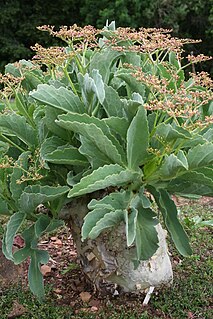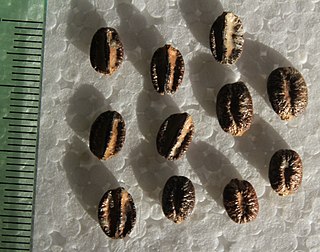
The Vitaceae are a family of flowering plants, with 14 genera and around 910 known species, including common plants such as grapevines and Virginia creeper. The family name is derived from the genus Vitis.

Ampelopsis, commonly known as peppervine or porcelainberry, is a genus of climbing shrubs, in the grape family Vitaceae. The name is derived from the Ancient Greek: ἅμπελος (ampelos), which means "vine". The genus was named in 1803. It is disjunctly distributed in eastern Asia and eastern North America extending to Mexico. Ampelopsis is primarily found in mountainous regions in temperate zones with some species in montane forests at mid-altitudes in subtropical to tropical regions. Ampelopsis glandulosa is a popular garden plant and an invasive weed.

Cyphostemma is a flowering plant genus in the family Vitaceae, with around 250 species distributed throughout the tropics and subtropics. These species are caudiciform and used to belong to the genus Cissus. The genus name comes from Greek kyphos, meaning hump, and stemma, meaning garland.

Tetrastigma is a genus of plants in the grape family, Vitaceae. The plants are lianas that climb with tendrils and have palmately compound leaves. Plants are dioecious, with separate male and female plants; female flowers are characterized by their four-lobed stigmas. The species are found in subtropical and tropical regions of Asia, Malaysia, and Australia, where they grow in primary rainforest, gallery forest and monsoon forest and moister woodland. Species of this genus are notable as being the sole hosts of parasitic plants in the family Rafflesiaceae, one of which, Rafflesia arnoldii, produces the largest single flower in the world. Tetrastigma is the donor species for horizontal gene transfer to Sapria and Rafflesia due to multiple gene theft events.

Ampelocissus is a genus of Vitaceae having 90 or more species found variously in tropical Africa, Asia, Central America, and Oceania. The type species, A. latifolia, was originally treated under its basionym, Vitis latifolia, and was collected from the Indian subcontinent.
Ampelocissus abyssinica is a large climbing vine native to southeast Ethiopia, where it is known in the Afaan Oromo language by the name teru, and is used as a herbal treatment for the medical condition known as black leg. Its first botanical description was in 1847 as Vitis abyssinica, that name being the basionym for its treatment here under the genus Ampelocissus.
Ampelocissus winkleri is a woody climbing vine, or liana in the grape family Vitaceae native to the island of Borneo. It was described botanically in 1910.
Ampelocissus africana is a type of vine that is woody, or liana of the grape family, bearing edible fruit. It is native to habitats in, and around forested areas in Guinea, Ivory Coast, Nigeria, Cameroon, Chad, Central African Republic, Sudan, Kenya, Rwanda, Burundi, Tanzania, Malawi, Zambia, Mozambique, Zimbabwe and Botswana. It was originally described botanically in 1790 by João de Loureiro as Botria africanus, which is the basionym for its treatment here under Ampelocissus.

Rhoicissus is an Afrotropical plant genus in the grape family Vitaceae and subfamily Vitoideae. There are between nine and twenty-two accepted species.
Ampelocissus barbata is a species of liana in the grape family Vitaceae. It was originally described from Sylhet by Nathaniel Wallich and placed in the genus Vitis. The species was moved to Ampelocissus by Jules Émile Planchon in 1884.

Rhoicissus rhomboidea is a climbing plant in the family Vitaceae, commonly known as the glossy forest grape. It is found in the eastern forests of southern Africa. The species was first described in 1859, treated under Cissus.

Ampelocissus asekii is a species of vine, in the family Vitaceae, from Morobe Province of Papua New Guinea. It is a close relative of Ampelocissus muelleriana Planch., another endemic of New Guinea and differs from the latter by its densely woolly tomentose lower leaflet surface and much thicker leaflets. The species is from the mid montane forests, whereas A. muelleriana occurs in the lowland rain forests. It is named after the type locality, the Aseki Patrol area in Morobe Province and was first described in 2013.
A. concinna may refer to:
Native grape may refer to certain plants within the family Vitaceae including:

Cissus cornifolia is a species of flowering plant in the Vitaceae family. It is an erect or semi-scandent woody shrub up to 3 meters in height belonging to the grape family of Vitaceae, and found from sub-Saharan Africa and Tropical Africa south to Botswana, Mozambique and South Africa. It is one of more than 300 species forming the genus Cissus.

Clematicissus is a plant genus in the family Vitaceae.
Pterisanthes is a plant genus in the family Vitaceae.

Clematicissus angustissima is a vine in the Vitaceae family, endemic to the Geraldton area of Western Australia.

Ampelocissus martini is a species of climber or shrub in the Vitaceae family. Some sources use the spelling Ampelocissus martinii. It is native to an area of Mainland Southeast Asia. The fruit are eaten by people and by several species of Pangasiidae shark catfish of the Mekong river.












